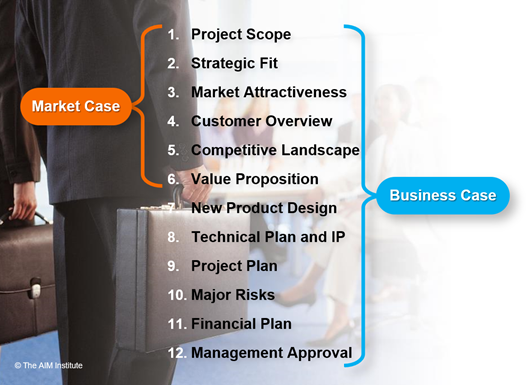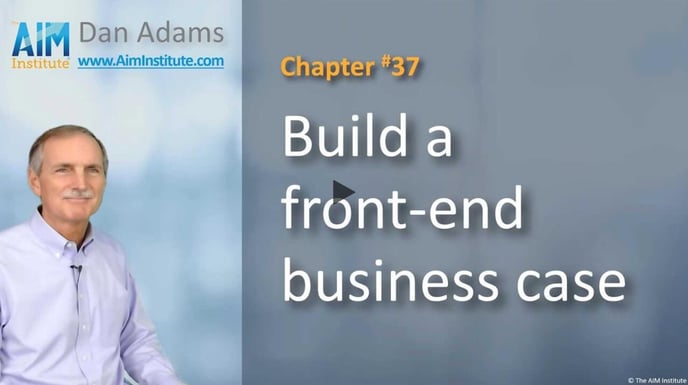1. When to build a Market Case
The Market Case is an abbreviated Business Case. Here's when to use it.
Many people are familiar with a Business Case: For new product development, this is what the team presents to management when it wants to enter the development stage. If your company uses a stage-and-gate process, your team typically has a gate review meeting with a Business Case to accomplish this. This review is sometimes called the “money gate,” because spending tends to go up rapidly when scientists and engineers start working in the lab.
The Blueprinting process includes a Business Case as its last step. So why do you need a Market Case? You could either use the Market Case as a checkpoint on your way to your Business Case (for larger projects)… or use the Market Case as the sole mechanism to begin the development stage (for smaller projects). For Blueprinting users, the following 12 sections are used in the Business Case, the first six of which comprise the Market Case:

The Market Case provides significant value all by itself. Your team uses this to say, “We think this is an attractive market segment and we understand what the customers in it want.” As you’ll see in the next article, Six parts of a Market Case, the 6th part of your Market Case (Value Proposition) includes a Market Satisfaction Gap chart… so you’re bringing to management solid evidence of customer needs. Not bad, right?
So why would you go beyond the Market Case to prepare a Business Case? The Business Case picks up where the Market Case leaves off: “We understand what this attractive market wants… and we even have some ideas on how we’ll satisfy those needs.” Teams that complete a Business Case enter their development stage with a clear roadmap of the technical avenues they will pursue. So the Business Case is especially helpful for maximizing development stage efficiency.
If you’re not sure if you should stop with a Market Case or proceed to a full Business Case, consider how much development time you think your project will require:
- If >1 person-year of development, use a Market Case
- If >2 person-years of development, also use a Business Case
So where did that come from? A study by the American Productivity & Quality Center showed that half of all companies spent less than 10% of their total project spending on the front-end… but the best companies spent 20-30% on the front-end. In rough terms, it might take your team a total of 3 person-months to create a Market Case… and a total of 6 person-months to create a Business Case.
Let’s do the math to target 20% of your total project spending on the front-end:
- Market Case: 3 months divided by (3 months + 12 months) = 20%
- Business Case: 6 months divided by (6 months + 24 months) = 20%
As you can see, this guideline is at least a decent starting point for determining your workload.
You can quickly download a Market Case Sample. Also, if you want to generate a sample using Blueprinter software, go to www.blueprintingcenter.com > Blueprinter software > DEMO: Acme Packaging project > Blueprinter Tool 3.7 > All Interviews. Then click the "Next" button 6 times and download the PDF and/or PPT version of the Market Case.
Also check out the 2-minute video, Build a front-end business case, part of the B2B Organic Growth video series by Dan Adams.
Keywords: Market Case, Business Case, short business case, project scope, strategic fit, market attractiveness, customer overview, competitive landscape, value proposition
